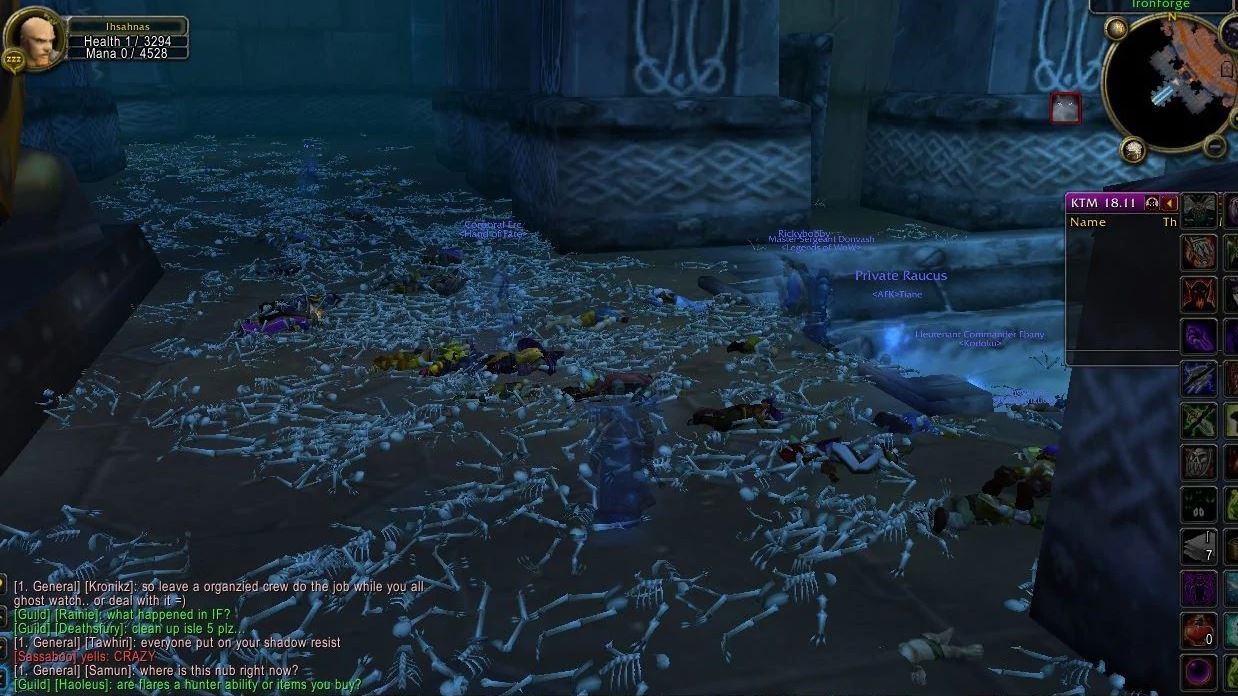"There was just a panic": Players, scientists, and Blizzard look back on World of Warcraft's Corrupted Blood Plague
How World of Warcraft's Corrupted Blood plague became a model for the fight against coronavirus

The date was September 13, 2005. It was supposed to be a day of celebration for Azeroth. The gates of Zul'Gurub had opened, and Horde and Alliance alike could finally storm its ruins for the promise of new adventures, glory, and untold riches. Yet, unbeknownst to both Blizzard and its then rapidly growing community of players, this ancient corner of Stranglethorn Vale was about to unleash a threat that would change the landscape of World of Warcraft forever.
"It's like two in the morning, and I get a phone call at home," recalls Jeff Kaplan, vice president at Blizzard Entertainment who was serving as lead designer on the World of Warcraft team at the time. "It's a Game Master panicking about some exploit; 'I'm killing all the players in Stranglethorn because they found an exploit with X, Y, or Z!'. And I'm like… 'Okay, step one: stop killing all the players in Stranglethorn!'"
That exploit, however, was far beyond the control of any Game Master by then. Instead, the source of the killings originated with Zul'Gurub's final boss fight, Hakkar the Soulflayer. Hakkar would inflict his attackers with a debuff spell known as Corrupted Blood, which not only sapped players of their health, but turned them into unwilling carriers of the disease itself, transmitting it to anyone in their proximity, including pets and NPCs.
The Corrupted Blood debuff was never meant to escape the raid zone, but a bug meant player's pets could carry the disease beyond ground zero through some unforeseen trickery, and were thus able to spread it to others outside of the previously quarantined instance. Within a matter of hours, Corrupted Blood had infected thousands of World of Warcraft players across Azeroth, with most of the major cities overrun by the outbreak, killing thousands on repeat and effectively stalling the entire game itself.
There will be blood


World of Warcraft timeline: A brief history of Azeroth all the way up to Shadowlands
"I remember it well," says longtime World of Warcraft player Eoin Winters, who had started their journey with the MMORPG just a few weeks before the incident took place. "I logged in one evening and Stormwind was just full of corpses. I thought maybe there'd been a Horde raid, so I just continued about my business. I went to the Auction House, and next thing I knew, I was dead. I couldn't for the life of me figure out what was wrong. I died three or four more times that day."
Things weren't looking good for the Horde, either. One player, Toronorith of Bonechewer, reminisces on what it was like to be in Orgrimmar at the time, describing the scenes at the Orc capital as a nightmarish tableau of "chaos, confusion, and pandemonium".
"In a world before social distancing, all you would see were dead bodies littered all throughout the Orgrimmar auction house," he tells me, pointing to World of Warcraft's real-time marketplace as the deadliest breeding ground for the virus' infection rates. "Trails of bodies from the auction house to other major points of interest, namely the bank, were a common sight for days. One could watch as people would resurrect at their corpse, only to catch the plague and die again seconds later. Eventually, people stopped going to Orgrimmar altogether. It was a virtual ghost town. As somebody guilty of spreading this plague, seeing the city abandoned gave me a smug sense of satisfaction."
Sign up to the GamesRadar+ Newsletter
Weekly digests, tales from the communities you love, and more

Tonnorith's final comment is emblematic of another unexpected side-effect of Blood Plague's descent on Azeroth. While this was a virus that originated from a forgivable oversight on Blizzard's part ("We forgot to check the flag that said 'Only Work In Zul'Gurub, Do Not Work Outside the Instance,'" jokes Kaplan), its efficacy was significantly amplified by the work of ill-intentioned players essentially acting as bioterrorists, deliberately passing the plague onto others to unleash further chaos upon their servers, and watching the fireworks unfold.
Not everyone used the pandemic to indulge their Hobbesian impulses, however. Members of the Priesthood even made a concerted effort at containment, assembling pop-up clinics where players could receive 'healing' via a 'Dispel Magic' buff that would remove the plague from a targeted host, as Winters explains.
"There were people in trade chat posting that they were at the entrance bridge to Stormwind dispelling people. That worked for about a day until Horde started ganking them, which just restarted the problem. By the third day, Stormwind was just empty."
Overwatch lead designer Geoff Goodman had been responsible for designing Zul'Gurub's boss fights in the lead up to its launch, and his initial reactions to early reports of the epidemic were surprisingly nonchalant, admitting that "bugs like that happened all the time" in World of Warcraft's nascent years. "When I first heard about it I was like, 'Ah man, that's annoying.' We knew it was kind of a niche bug, where you had to get this debuff on your pet, then dismiss it, then resummon it, you have to work really hard to catch it. I didn't think much of it. But it sort of became this epic historical thing."
Server corrupted

The Corrupted Blood Incident became more than just a chapter for the World of Warcraft history books. It gave epidemiologists one of the best real-time models of scale for understanding how and why a disease spreads in the way that it does, providing insight that scientists around the world are still using to this day to now fight the Coronavirus. Dr. Eric Lofgren was one of the earliest students of the Blood Plague pandemic; a regular player of World of Warcraft himself, he eventually co-wrote a paper on the "the untapped potential of virtual game worlds to shed light on real world epidemics".
"The main thing we took away from it was the importance of understanding human behavior – and how difficult that is to actually do well,' he tells me." We saw a lot of unexpected things – altruism on the part of people who could heal other players, a lot of informal discussion and speculation about the epidemic on the social media outlets available at the time. Often, the models we use to study epidemics have very abstract representations of individual behavior patterns, and there's a lot of complexity there when you start digging in."
While epidemiologists are able to run highly advanced pandemic prediction models using artificial intelligence and existing real-world data, the Corrupted Blood Incident handed the scientific field an example where, not only was the data easily accessible (unlike our existing situation, Blizzard knew exactly how many people had Corrupted Blood at any one time throughout the pandemic), but its participants were real people. Indeed, fifteen years after Corrupted Blood broke out, Lofgren is able to identify a number of behavioral patterns from the COVID-19 crisis that Azeroth's outbreak first warned us about.

"One of the main criticisms of our paper when it came out was that there were trolls and griefers in the game who were making things worse, and that would never happen in real life. At the time, we discussed some behaviors that could cause a similar effect – "presenteeism", where someone goes to work even though they're sick because they don't have sick days, don't want to let their team down, and so on. Sadly, with COVID-19, I think we have a great many more examples of people willfully ignoring public health guidelines and contributing to the spread of the infection."
It took a gruelling number of days, but Blizzard eventually managed to put an end to the plague by initiating several hard resets of World of Warcraft's servers, while patching out the pet exploit that allowed Corrupted Blood to escape Zul'Gurub in the first place. Despite the drama of it all, Kaplan looks back on the entire saga with a strange sense of nostalgia, calling it just one of many "panic moments" that rallied the development team together in the early days of the MMO's lifespan.
"At the time we were not like, 'Oh, we can actually do computer modeling around what a pandemic might look like', or whatever. At the time, it was just like, 'Oh, man, another one of these horrible bugs that's killing our players.' But it's cool to have a bug that was so epic, that even now people are still talking about it. It's kind of amazing!"

"It's cool to have a bug that was so epic, that even now people are still talking about it. It's kind of amazing!"
Geoff Kaplan
"It's just so funny to me that it became this thing because, at the time, it was just another bug to fix," agrees Goodman. "I just didn't think about it like that."
With World of Warcraft: Shadowlands out today, players will be heading into Azeroth's afterlife as the real world around them continues to deal with a pandemic which has upended the fabric of society as we know it. Blizzard's upcoming expansion will no doubt be a much-needed source of escapism and respite for many, then, but the Corrupted Blood Incident remains a potent cautionary reminder that even digital worlds aren't immune to the ever-present threat of contagion.
For more, check out the best MMORPG games to play right now, or watch our episode of Dialogue Options below to discover more titles we've spent over 100 hours in.
I'm GamesRadar's Features Writer, which makes me responsible for gracing the internet with as many of my words as possible, including reviews, previews, interviews, and more. Lucky internet!



